Long Fur Cats, with their luxurious coats and graceful demeanor, have captivated cat lovers for centuries. These felines often exude an air of elegance and regality, adorned with features like impressive fluffy manes, voluminous tails, charming ear tufts, and delightful tufts of fur peeking out from between their paws. Contrary to common belief, owning a cat with long fur doesn’t automatically equate to endless grooming sessions. In fact, the grooming needs vary considerably across different long-haired breeds.
Let’s delve into the fascinating world of long fur cats and explore some of the most beloved and distinctive breeds.
Popular Breeds of Long Fur Cats
1. Persian: The Epitome of Long-Haired Elegance
 red persian cat lying on a chair with a woman at a desk in the background
red persian cat lying on a chair with a woman at a desk in the background
Alt text: A regal red Persian cat lounges gracefully on a chair, showcasing its long, flowing fur in a domestic setting.
Renowned for their strikingly flat faces and incredibly long, flowing coats, Persian cats stand out as one of the most iconic long fur cat breeds. Their gentle and placid nature makes them ideal companions for tranquil and peaceful households. Persians are known to form deep bonds with their families, offering affection and companionship, though they can sometimes be reserved when meeting new people.
The Persian breed boasts an impressive array of coat colors, from classic blacks, reds, and creams to more unique and sought-after shades like blue and lilac, perfect for those desiring a gray long fur cat. However, their magnificent fur comes with a commitment: daily grooming is essential. This routine helps to keep their coats free of tangles and debris, and importantly, prevents painful matting, especially around their delicate facial area.
2. Himalayan: A Colorful Pointed Beauty with Long Fur
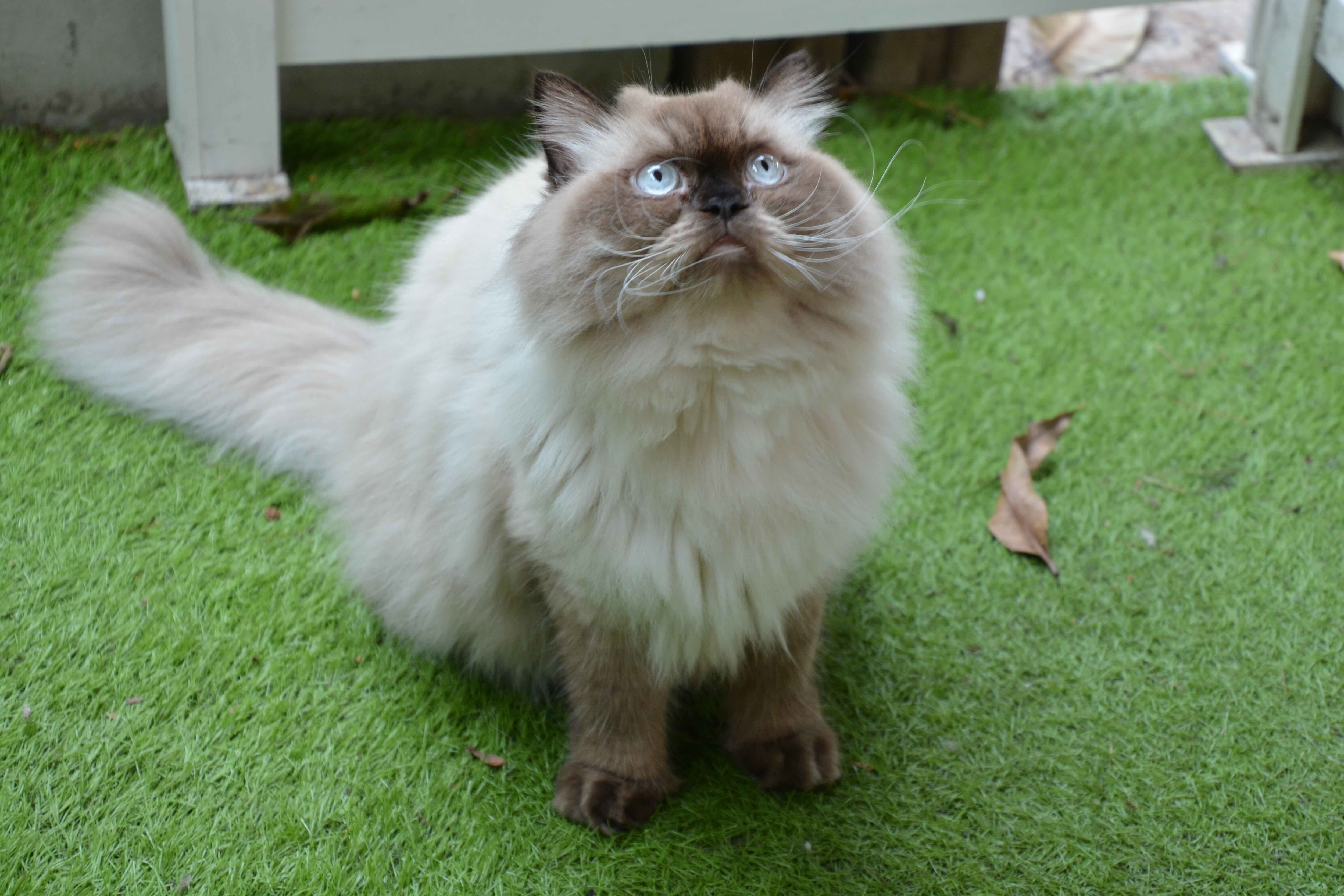 silver colorpoint himalayan cat sitting in grass and looking up
silver colorpoint himalayan cat sitting in grass and looking up
Alt text: A silver colorpoint Himalayan cat, with its long, creamy fur and darker facial points, sits alertly in a grassy outdoor setting.
The Himalayan is a delightful and playful long fur cat breed, a result of crossbreeding Persians with Siamese cats. Their most distinguishing feature is their striking “pointed” coloration – darker shading on their ears, face (mask), paws, and tail, contrasting beautifully with their lighter body coat.
These points come in a variety of colors, including the classic seal (black with warm undertones), blue, lilac, chocolate, and flame (red-orange). These colors can also appear in solid or patterned forms. Himalayan fur can range from fine and silky to a thicker, wooly texture, but regardless of the specific coat type, daily brushing remains crucial to maintain its health and beauty and prevent knots in their long fur.
3. LaPerm: Naturally Curly Long Fur Wonder
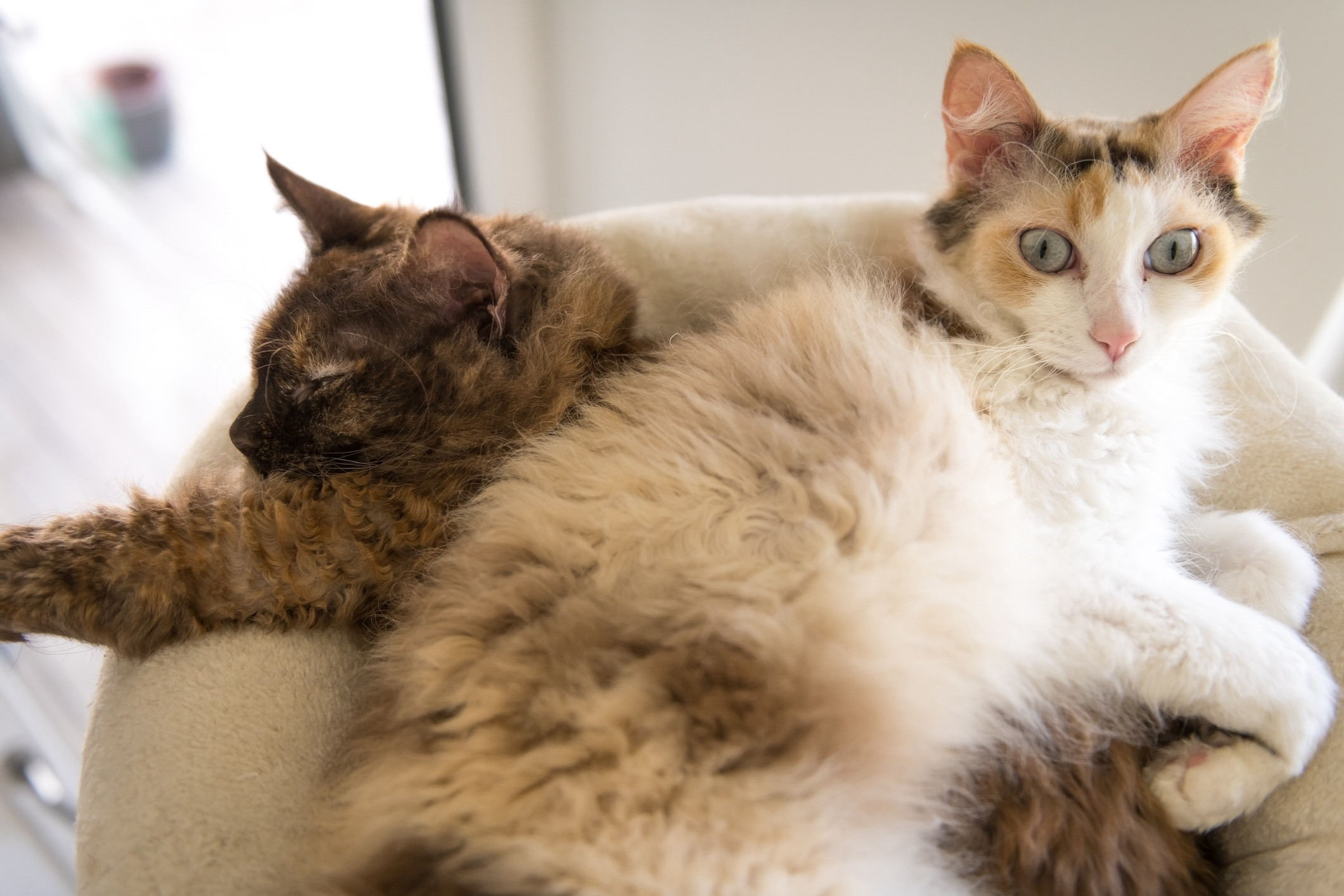 two laperm cats lying together in a cat tree
two laperm cats lying together in a cat tree
Alt text: Two LaPerm cats with their distinctive curly long fur resting together comfortably in a cat tree.
For those seeking a truly unique long fur cat, the LaPerm, with its naturally curly coat, is a captivating choice. This breed’s wavy or curly fur is a result of a spontaneous natural genetic mutation. Interestingly, LaPerms can have both long and short coats, but the long-haired variety is particularly striking.
Long fur LaPerms possess a medium to long coat that can range from soft waves to tighter curls, with a distinctive springy and airy feel, as described by the Cat Fanciers’ Association (CFA). Despite their luxurious long fur, LaPerms are surprisingly low-shedding and are known for their affectionate and active personalities, making them wonderful, playful companions.
4. Maine Coon: The Gentle Giant with a Long, Flowing Coat
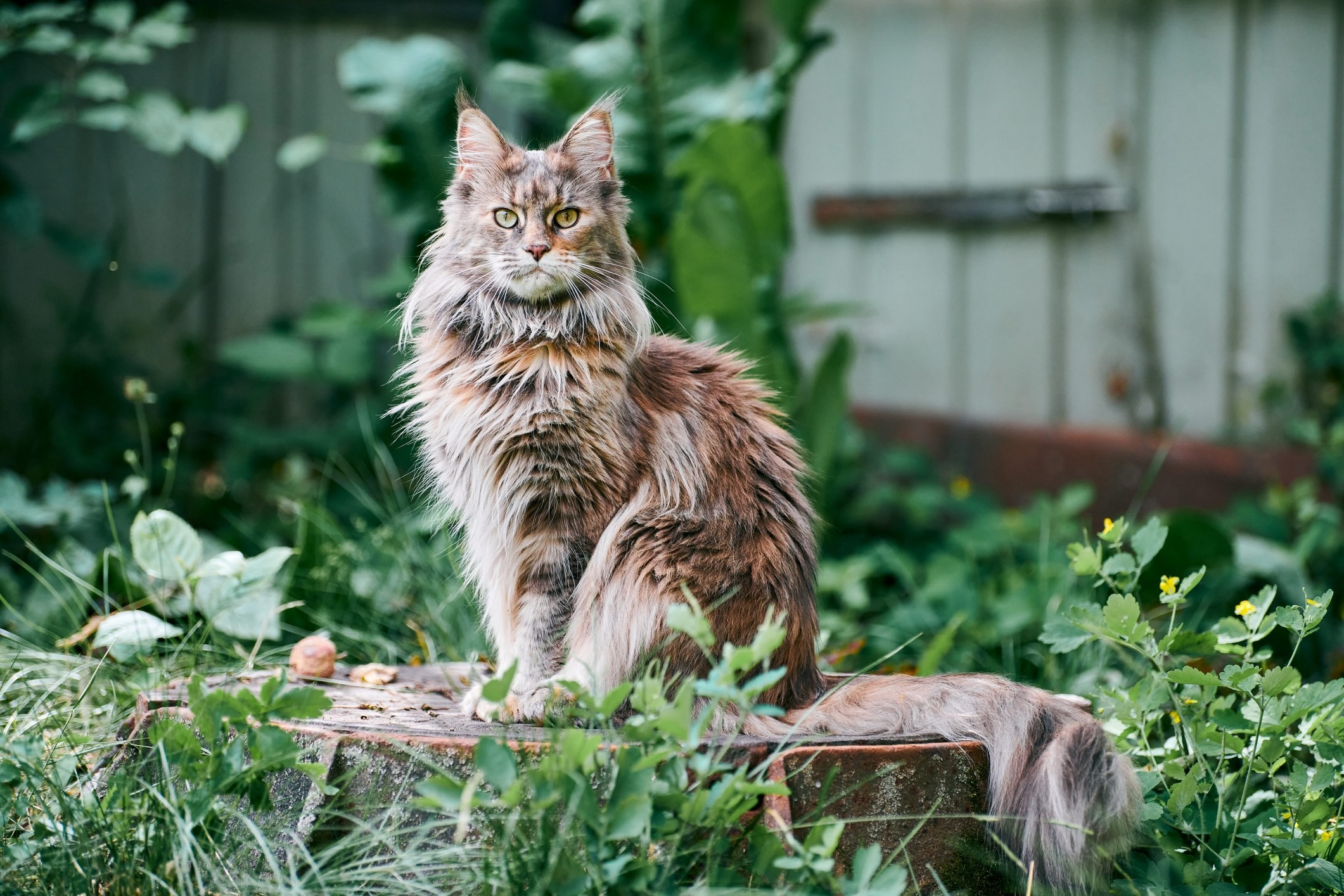 brown and orange maine coon tabby sitting in a garden
brown and orange maine coon tabby sitting in a garden
Alt text: A large brown and orange Maine Coon tabby cat with long fur sits regally in a lush garden setting.
The Maine Coon is truly impressive. Their substantial size, magnificent long fur, and extra-long whiskers contribute to their grand appearance. These gentle giants are known to be wonderful companions, often described as affectionate and intelligent, with many exhibiting almost dog-like loyalty and traits.
As one of the largest long fur cat breeds, a fully grown Maine Coon can weigh up to 25 pounds or even more. Their thick, water-resistant double coat requires regular attention; brushing a few times a week is essential to keep their fur looking its best and to prevent tangles and mats from forming in their dense long fur.
5. Norwegian Forest Cat: A Hardy Long Fur Cat from Scandinavia
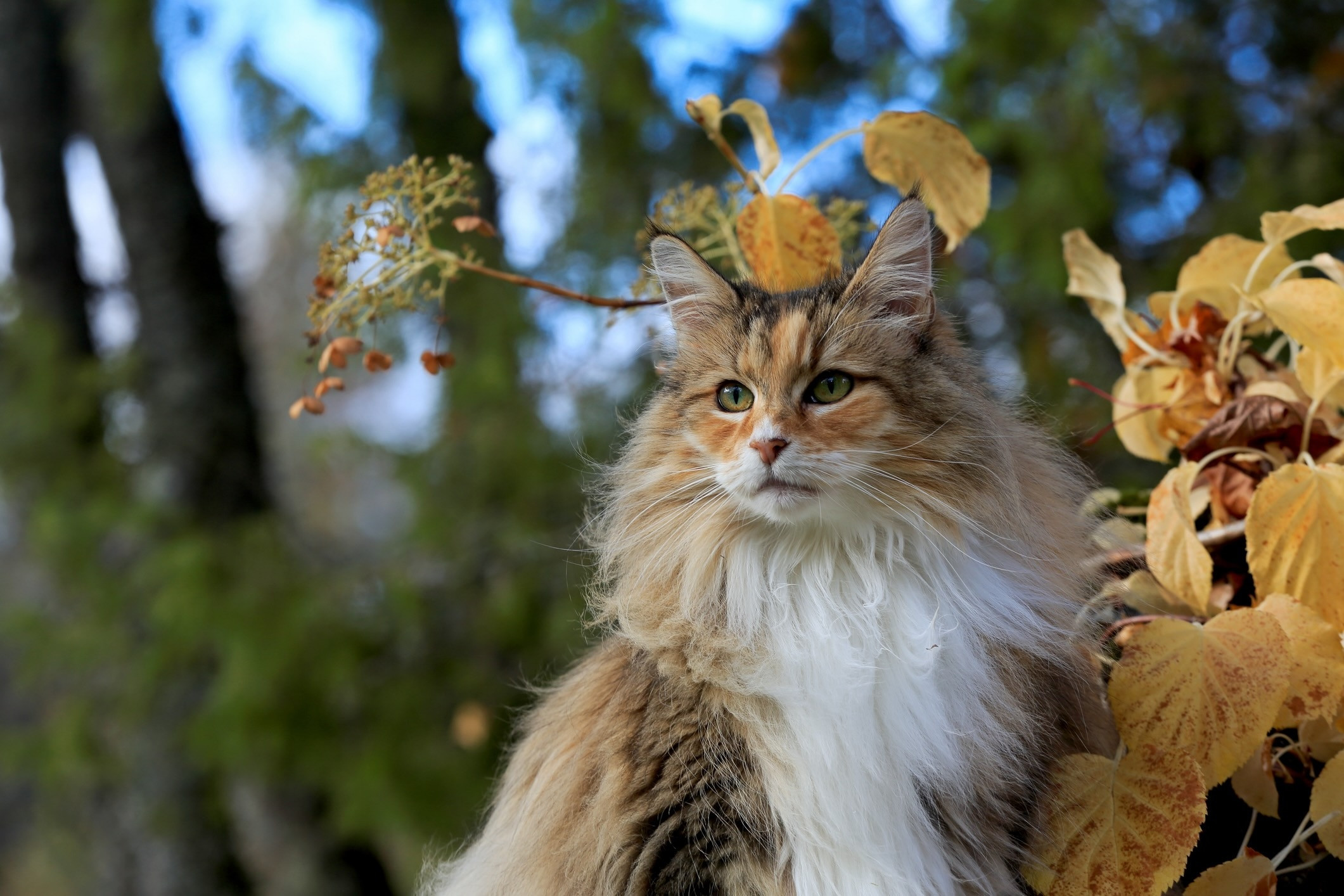 white, brown, and organge norwegian forest cat close-up outside
white, brown, and organge norwegian forest cat close-up outside
Alt text: A close-up portrait of a Norwegian Forest Cat with white, brown, and orange long fur, outdoors.
Another large and striking long fur cat breed is the Norwegian Forest Cat. Developed in the harsh climates of Scandinavia, these cats have evolved with a thick, insulating double coat to protect them from freezing winters. This impressive fur requires regular brushing, ideally several times a week, to manage shedding and maintain its healthy condition.
Twice a year, during shedding season, Norwegian Forest Cats will shed a significant amount of their undercoat. During these periods, more frequent brushing becomes necessary to keep loose fur under control. Despite their grooming needs, their sociable and affectionate nature makes grooming sessions enjoyable, as they typically love spending time with their human families.
6. Ragdoll: The Relaxed and Affectionate Long Fur Companion
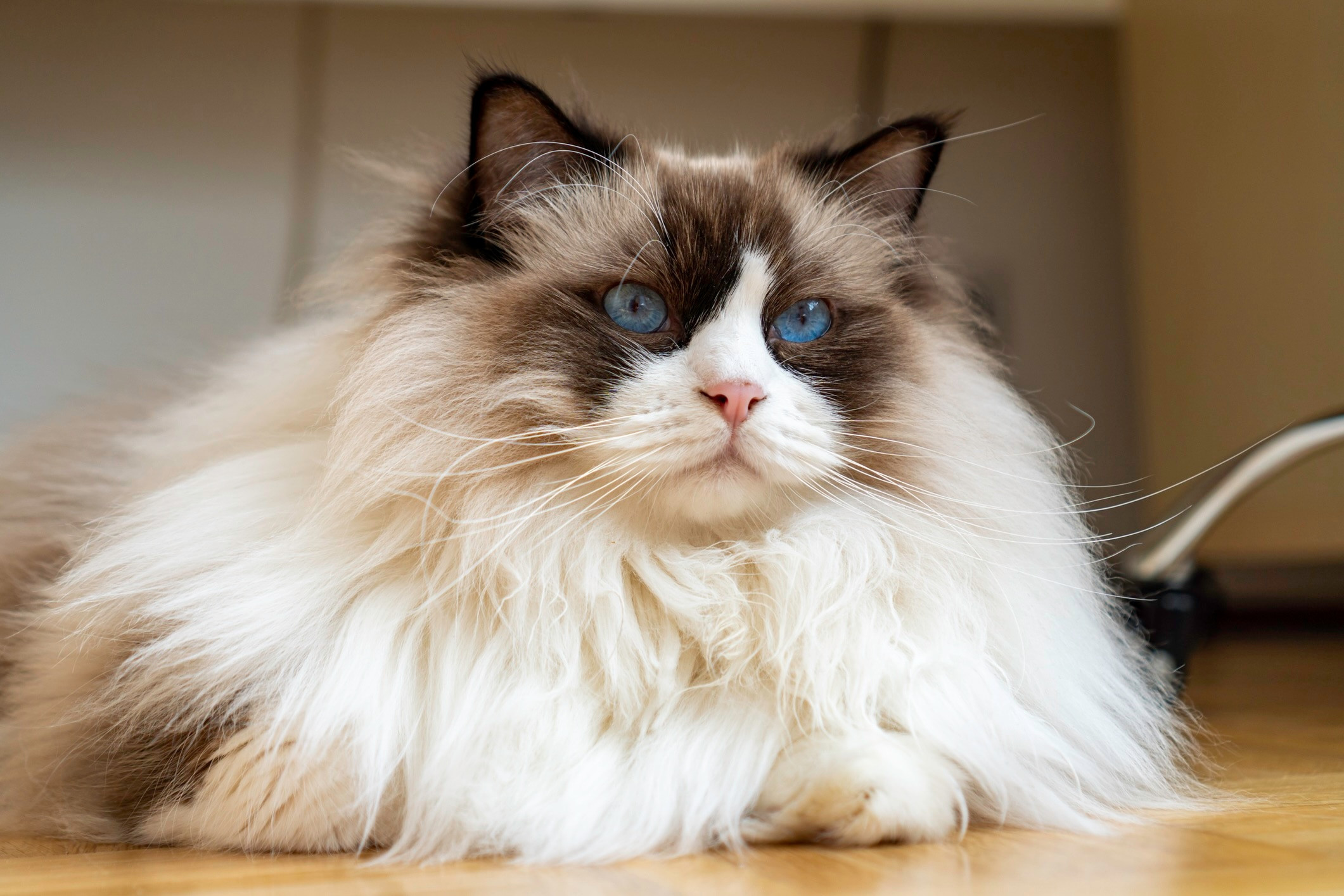 close-up of a longhaired ragdoll cat lying on the floor
close-up of a longhaired ragdoll cat lying on the floor
Alt text: A close-up view of a Ragdoll cat with soft, long fur, lying serenely on a floor.
The Ragdoll breed is famed for its exceptionally gentle and docile temperament. They are known for their love of affection, often going completely limp and relaxed when held or petted – hence their name, Ragdoll.
Ragdolls are considered among the friendliest of cat breeds and thrive in homes where they receive plenty of attention, either from other pets or humans who are frequently at home. Beyond their need for companionship, their long fur care is relatively simple. Brushing once or twice a week is usually sufficient to keep a Ragdoll’s coat healthy, tangle-free, and beautiful.
7. RagaMuffin: Sweet-Natured and Easy-Care Long Fur Cat
The RagaMuffin shares close lineage with the Ragdoll and is equally celebrated for its affectionate and gentle disposition and strong bonds with family members. This long fur cat breed is characterized by a luxuriously soft and silky coat, featuring a charming ruff around the neck and slightly longer fur on their belly.
While their coat appears opulent, it’s surprisingly low-maintenance. Weekly grooming with a comb is generally enough to keep a RagaMuffin’s long fur in excellent condition, making them a wonderful choice for owners seeking a beautiful long fur cat without demanding grooming needs.
8. Siberian: A Hypoallergenic Long Fur Cat with a Triple Coat
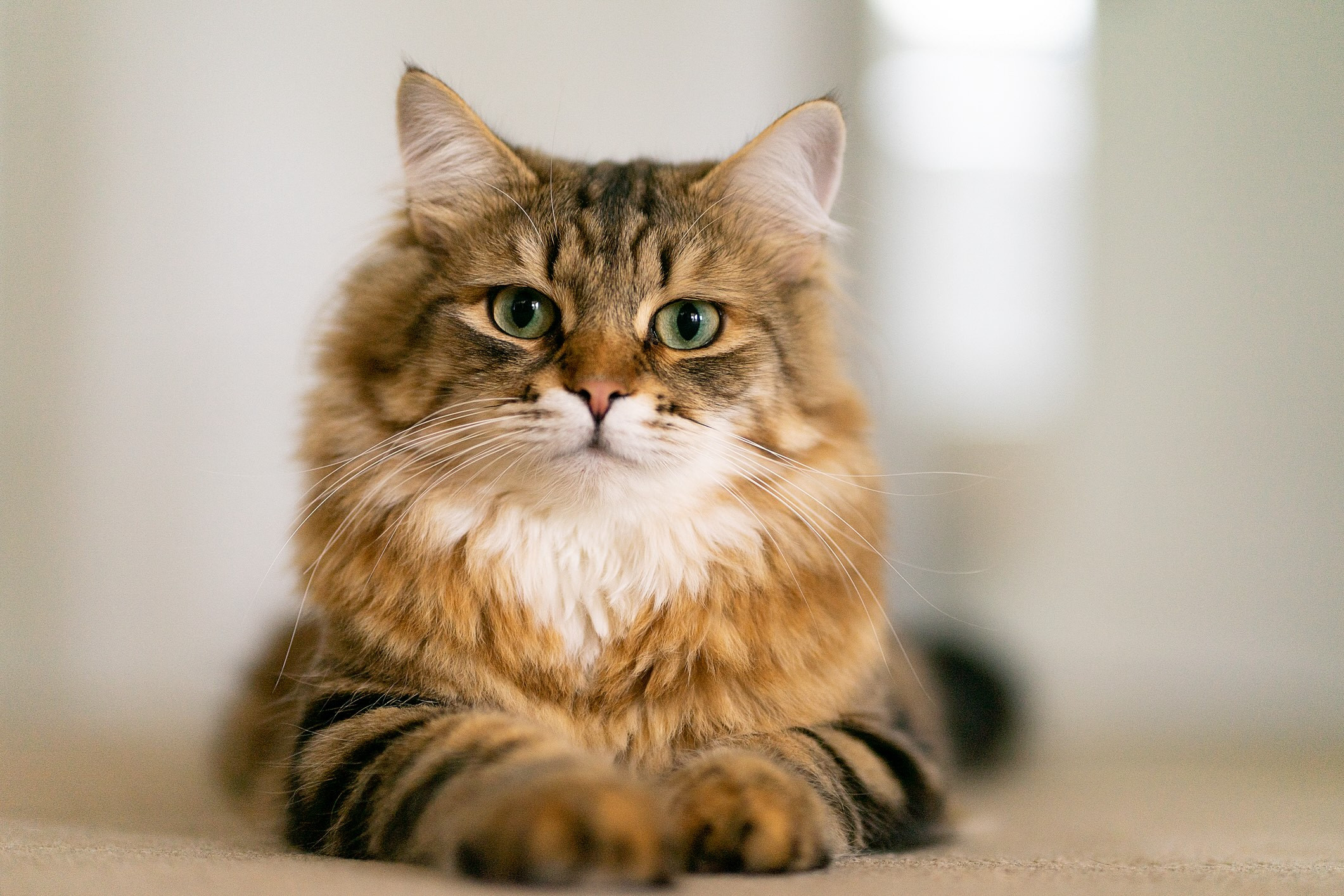 brown tabby longhaired siberian cat lying down and looking at the camera
brown tabby longhaired siberian cat lying down and looking at the camera
Alt text: A brown tabby Siberian cat with long, dense fur lying down and looking directly at the camera.
Compared to other long fur cat breeds, the Siberian cat is unique due to its triple coat. This consists of guard hair, awn hair, and a dense undercoat, providing exceptional insulation. Despite the abundance of fur, Siberian cats only require weekly grooming for most of the year.
However, during the spring and fall shedding seasons, more frequent brushing, potentially daily, is necessary to manage the molting undercoat. Siberians are renowned for their friendly and playful nature. They are known to be lap cats and are also intelligent, active, and trainable, making them engaging and interactive long fur companions. Interestingly, they are often considered more hypoallergenic than some other breeds, potentially due to lower levels of the Fel d 1 protein in their saliva, which is a common cat allergen.
9. Selkirk Rex: The Curly Long Fur Teddy Bear Cat
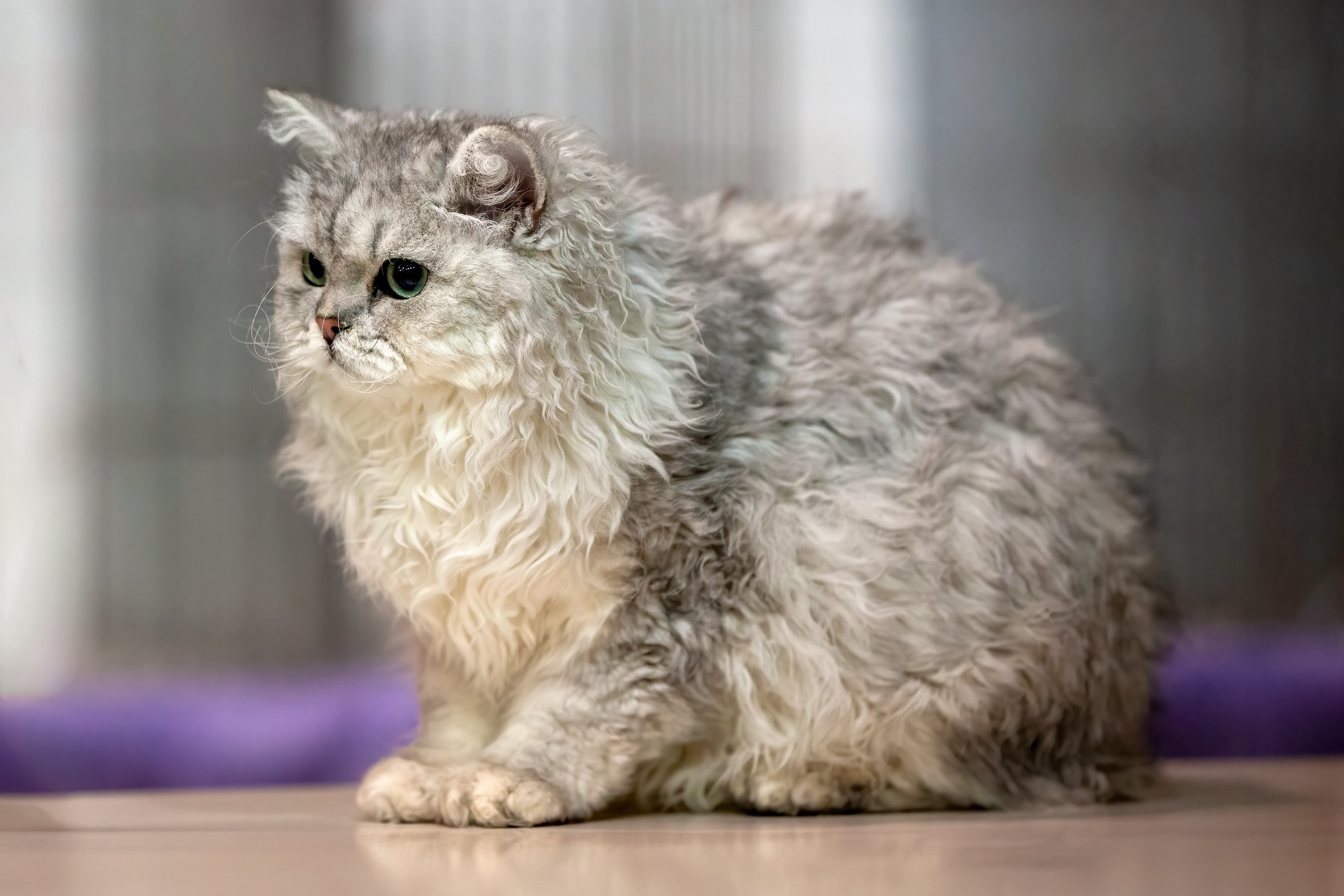 curly-haired selkirk rex sitting on the floor
curly-haired selkirk rex sitting on the floor
Alt text: A Selkirk Rex cat with its distinctive curly long fur sitting upright on a floor.
The Selkirk Rex is another curly-coated breed, inheriting its unique fur texture from a naturally occurring gene mutation. Their long and fluffy fur is a legacy from Persian lineage in their breed development, resulting in a delightful “teddy bear” appearance. Unlike many long fur cat breeds, the Selkirk Rex should not be brushed excessively, as over-brushing can disrupt their curls and lead to frizziness.
These fluffy cats can be prone to oily skin and may benefit from semi-regular baths. Establishing a gentle grooming and bathing routine early in a Selkirk Rex’s life is beneficial to make these processes easier and more comfortable for the cat as they mature.
10. American Bobtail: A Shaggy Long Fur Cat with a Short Tail
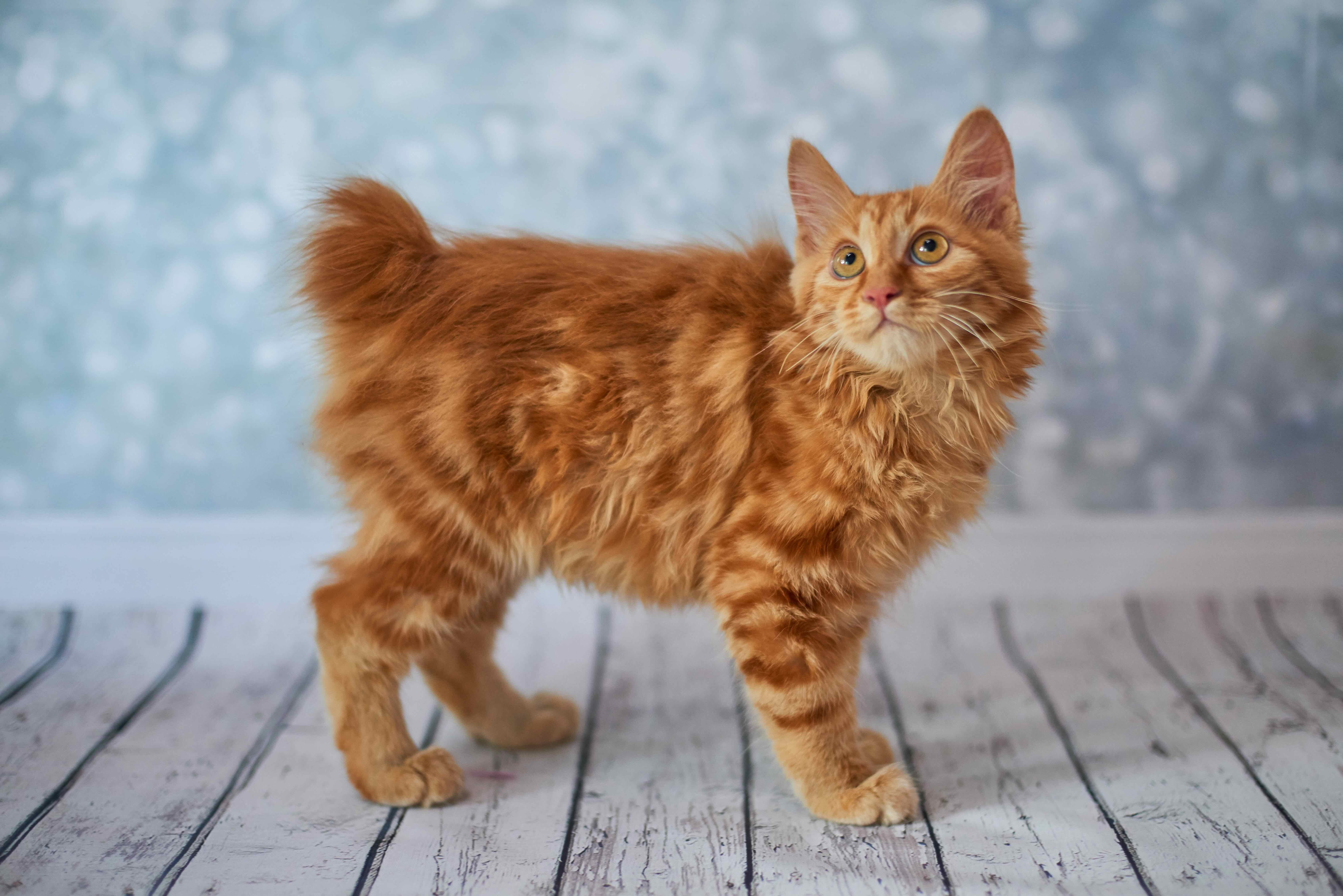 fluffy red american bobtail kitten
fluffy red american bobtail kitten
Alt text: A fluffy red American Bobtail kitten with its characteristic short tail.
The American Bobtail is recognized for its shaggy, medium-long coat and, most notably, its naturally short tail. The length of the bobtail can vary, but it can be as short as just one inch.
According to The International Cat Association (TICA) breed standards, American Bobtails can exhibit any coat color and pattern. You might find a fluffy brown cat or a striking long fur orange cat within this breed. They are medium-sized, adaptable, and affectionate cats, often described as having a playful and trainable nature, capable of learning tricks and enjoying interactive games.
11. Birman: The Sacred Cat of Burma with Silky Long Fur
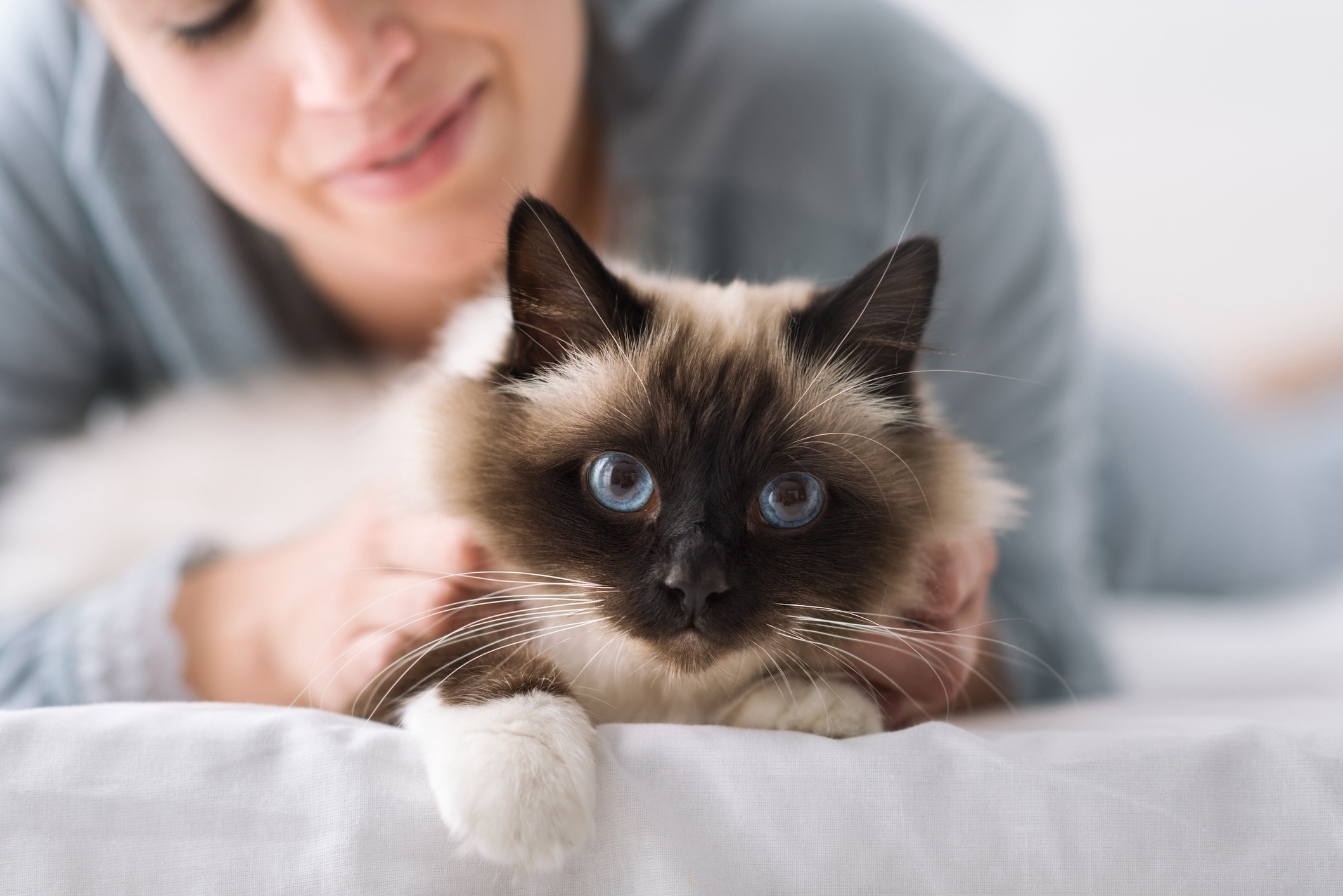 woman petting a longhaired birman cat on a bed while the cat looks straight at the camera
woman petting a longhaired birman cat on a bed while the cat looks straight at the camera
Alt text: A woman gently pets a Birman cat with long, pointed fur on a bed, as the cat looks directly at the camera.
With their captivating bright blue eyes and a striking coat of white or cream accented by darker points on the face, tail, and legs, the Birman is an undeniably beautiful long fur cat breed.
For those concerned about demanding grooming routines, Birman cats offer good news. Their long, silky coat is less prone to tangling and matting compared to some other long fur breeds. However, regular brushing a few times a week is still recommended to minimize shedding and reduce the likelihood of hairballs.
12. Japanese Bobtail: A Long Fur Cat with a Pom-Pom Tail
The long fur Japanese Bobtail is characterized by its unique tail, which is naturally short and kinked, resembling a pom-pom, and should be no longer than 3 inches. They have a medium to long, silky coat that lacks a prominent undercoat. This smooth, fine fur is relatively easy to maintain with regular weekly brushing.
Japanese Bobtails come in a wide array of colors and patterns, including solid colors as well as bi-color and tri-color combinations. They are known to be highly interactive and social cats, often vocalizing to get attention and readily befriending new people, making them engaging and communicative long fur companions.
13. Pixiebob: The Wildcat Lookalike with a Gentle Long Fur Coat
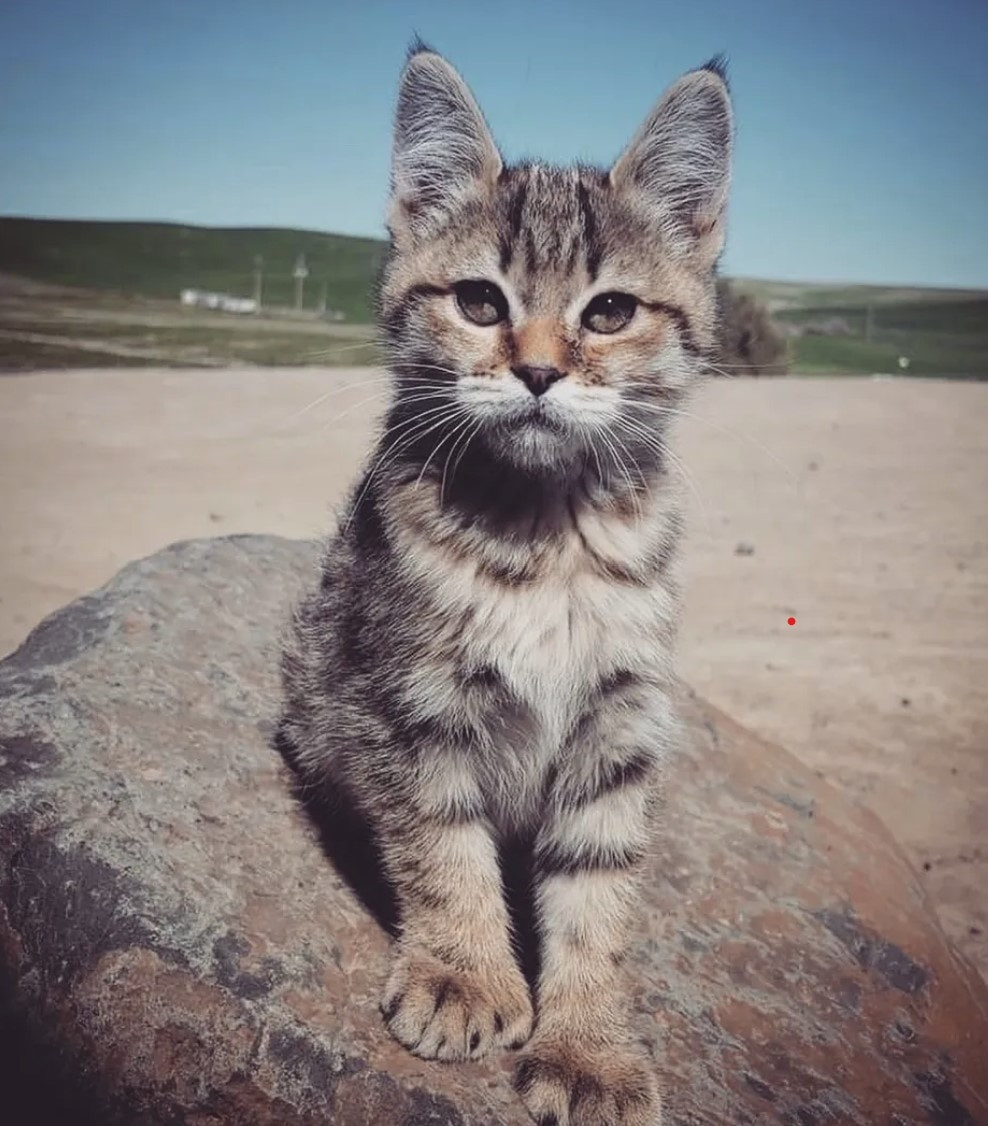 pixiebob kitten with extra toes sitting and looking at the camera
pixiebob kitten with extra toes sitting and looking at the camera
Alt text: A Pixiebob kitten with polydactyl paws and long fur sits and gazes at the camera.
The Pixiebob breed was developed to resemble the wild North American bobcat. The breed standard recognizes both shorthaired and long fur coat types. Both varieties are described as having full and bushy facial fur, contributing to their wild appearance.
Long fur Pixiebob cats possess a soft coat that is approximately 2 inches in length and lies close to the body. Despite their wildcat looks, Pixiebobs have a relaxed and friendly temperament, making them wonderful and affectionate house cats, despite their somewhat untamed appearance.
14. Turkish Angora: A Silky, Low-Maintenance Long Fur Cat
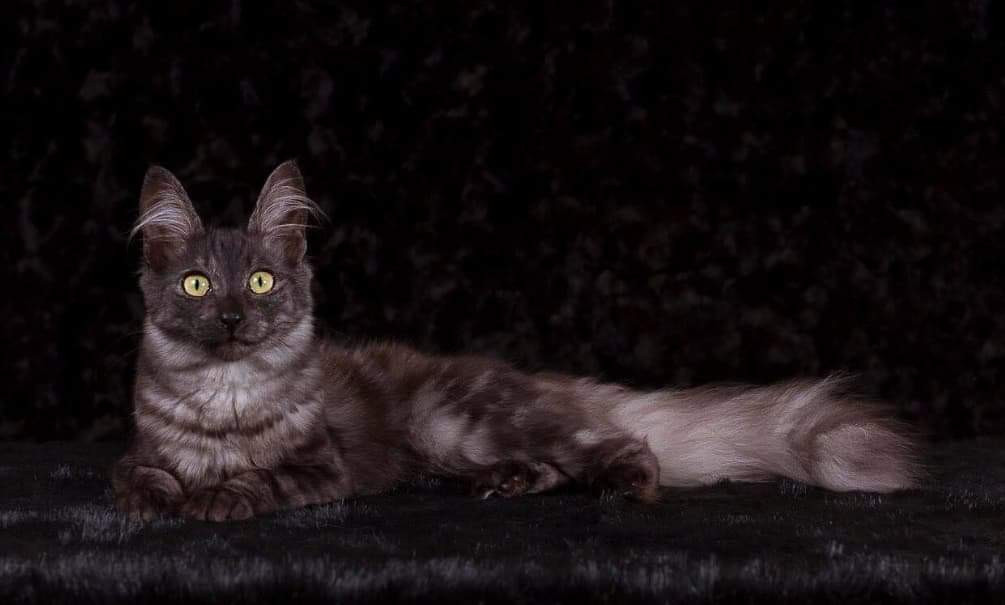 black turkish angora lying down on a black background
black turkish angora lying down on a black background
Alt text: A sleek black Turkish Angora cat with long, silky fur lying down against a black backdrop.
The Turkish Angora is known for its stunningly smooth and silky coat, which is as beautiful as it is easy to care for. Lacking an undercoat, Turkish Angoras are less prone to matting, although brushing a few times per week is still recommended to keep their long fur in top condition.
Compared to some other long fur cat breeds, the Turkish Angora may not be as overtly cuddly. However, they are playful and enjoy active interactions with people and other pets. They are also known to be quite vocal, adding to their engaging personalities.
15. Turkish Van: The Swimming Long Fur Cat
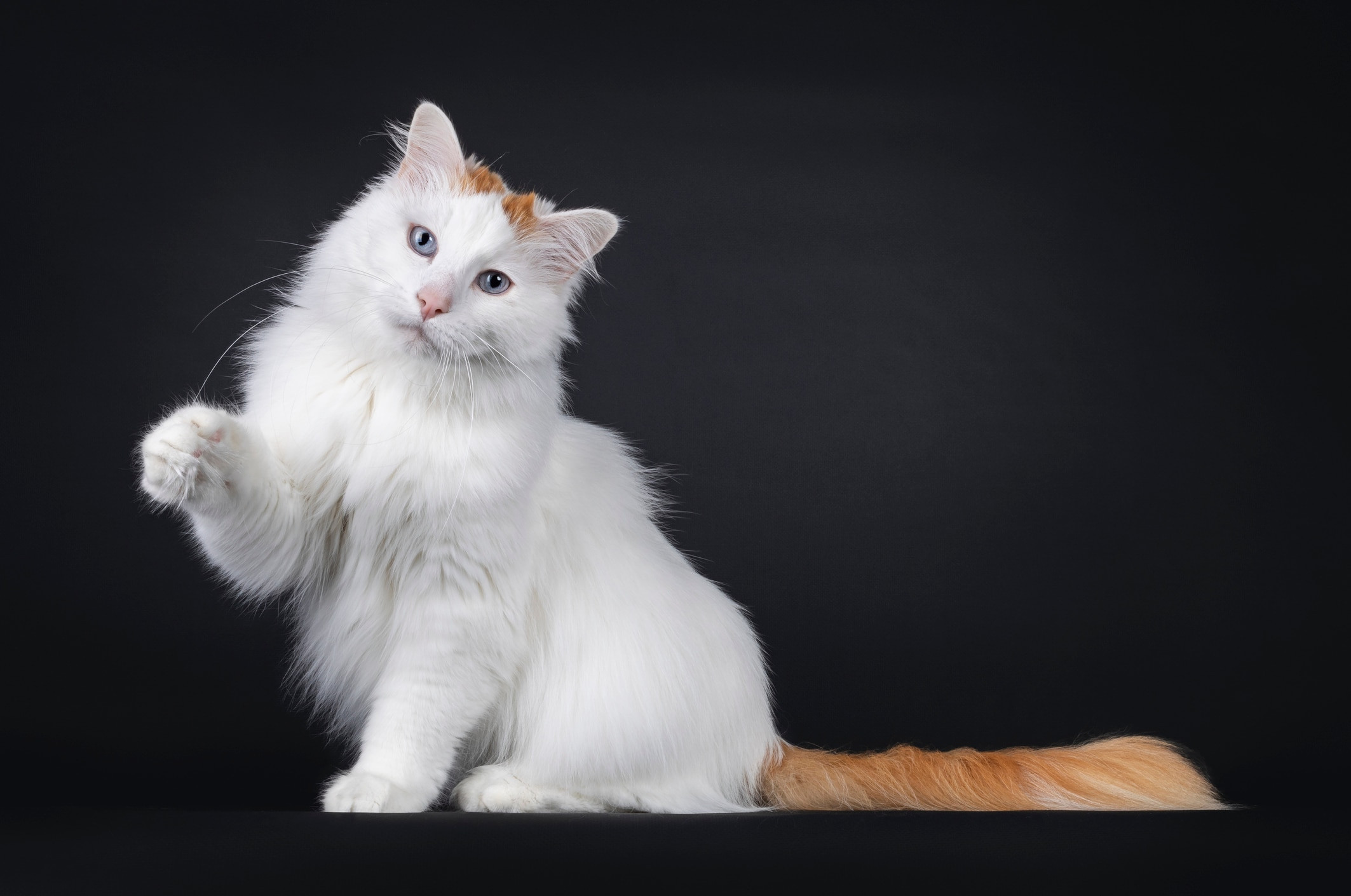 white and orange turkish van cat on a black background
white and orange turkish van cat on a black background
Alt text: A white and orange Turkish Van cat with its distinctive long, semi-long fur pattern against a black background.
Another relatively low-maintenance long fur cat breed is the Turkish Van. Interestingly, Turkish Vans are born with shorter coats that gradually develop into their signature semi-long fur by the time they are 3 to 5 years old.
Even as adults, their coat changes seasonally, becoming shorter in the summer and growing thicker and longer in the winter months. Throughout the year, the Turkish Van is characterized by a full, bushy tail and charming ear tufts. They are also known for an unusual trait among cats: a love for water and swimming!
Caring for Your Long Fur Cat Breed
Generally, caring for long fur cats shares many similarities with caring for any cat. They require proper nutrition through a balanced diet, mental stimulation through play and interaction, and essential resources like a clean litter box and engaging cat toys. However, long fur cat breeds often have more demanding grooming needs.
The most critical aspect of care for cats with long fur is regular brushing and routine nail trims. Investing in a good quality comb and brush designed for long fur is essential for effectively removing loose fur, reducing dander, and keeping their coats smooth and tangle-free.
Learning the correct techniques for brushing your long fur cat is important. Make grooming a positive experience by offering plenty of praise, gentle affection, and tasty treats throughout the session. However, be mindful not to over-brush, as excessive brushing can sometimes lead to hair breakage and a frizzy texture.
If you encounter a stubborn mat that is difficult to remove gently and quickly, it is best to seek assistance from a professional groomer. In fact, regular visits to a professional groomer can be highly beneficial for some long fur cat breeds, particularly those with very dense coats like Persians or Siberians. A groomer can provide thorough brushing, professional mat removal, and even offer trims to simplify at-home grooming and maintain your long fur cat’s coat in optimal condition.
